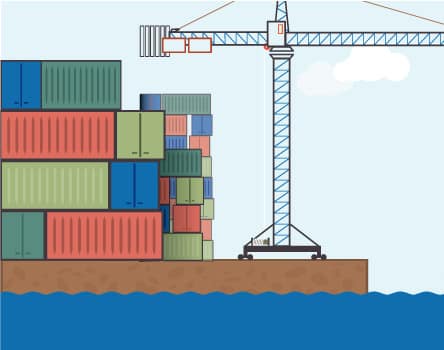In the high-stress, non-stop world of eCommerce, customer satisfaction very often comes down to the speed of delivery. No matter the size of the business, research shows the gold standard for getting packages to consumers’ doors is very quickly becoming 2-day shipping.
Such speedy service was once thought to be out of reach for smaller operations. But with long delivery times driving away at least half of the customers in the market, eCommerce stores of all stripes should be finding a way to offer this coveted option, recognizing it as a key differentiator in today’s competitive market. This evolution reflects a shift in consumer demand and a massive opportunity for growth-oriented businesses to stand out by exceeding expectations.
Transforming your delivery approach doesn’t mean starting from scratch. How you position your inventory makes a huge difference.
By strategically locating your products closer to your customer base, you can dramatically shorten delivery times and cut down on costs. This makes it easier to deliver exceptional service without a complete overhaul of your existing system, streamlining operations and placing your business in a prime position to meet the fast-paced demands of the eCommerce world.
Here we’ll take a look at when to start thinking about 2-day shipping for your business, how to practically implement this service through strategic warehouse placement, and the benefits it brings.

When Do You Need To Provide 2-Day Shipping?
As your eCommerce business grows from the ground up, the decision to offer 2-day shipping moves from a “maybe one-day” dream to a strategic necessity. This moment is different for every company but, to give you a ballpark estimate you can use: it starts to make sense when average monthly order volume typically exceeds 250 orders.
That’s because this is usually around the time when it becomes viable to split inventory between two warehouses. When eCommerce businesses reach this level, offering 2-day shipping becomes an investment in customer satisfaction and retention without disproportionately increasing overhead.
That’s not the only reason 2-day shipping is so high on everyone’s list. As you analyze customer feedback and shipping data, look for increased cart abandonment rates or direct customer feedback about delivery times can signal that your shipping speed is falling behind customer expectations. A high abandonment rate could indicate that your current shipping speeds do not meet customer expectations.
Tools like Google Analytics can help track these trends or answer the questions you’re asking, offering data on how shipping options impact conversion rates. Additionally, customer satisfaction surveys can provide qualitative feedback on shipping preferences, highlighting the demand for faster delivery through their direct words.
Another technical consideration is the analysis of shipping zones and their impact on delivery times and costs. Most shipping carriers divide the country into zones – the further a package travels, the higher the shipping cost and the longer the delivery time.
By examining your customer distribution and order history, you can identify where most of your customers are located, which might reveal that a significant portion of your customer base is concentrated in specific areas. If these areas are currently beyond the reach of 2-day ground shipping from your primary fulfillment center, it could be time to consider a multi-warehouse strategy to bring your products closer to your customers, reducing both costs and delivery times.
When your analytics indicate that long delivery times are a major concern for your customers, it’s a clear sign to enhance your competitiveness and foster customer loyalty by implementing 2-day shipping.

Choosing The Right Warehouse Locations is the Key to 2-Day Shipping
Strategic warehouse placement is a game-changer for any eCommerce business aiming to offer 2-day shipping, especially smaller outfits. This approach involves distributing your inventory across multiple locations to minimize shipping times and costs.
Here’s how to implement this strategy effectively:
- Understand Your Customer Base: The first step is to analyze your order history and customer data to identify the geographical distribution of your customers. This will determine the most strategic locations for where your warehouses or products need to be staged.
- Analyze Your Shipping Zones: Shipping carriers like USPS divide the country into zones. Review these zones concerning your customer base to understand how you can minimize shipping distances. This will speed up delivery times and reduce shipping costs.
- Choose Your Warehousing Partners Wisely: For small eCommerce businesses, partnering with a third-party logistics provider (3PL) can offer access to strategically located warehousing without the need for significant investment. Fulfillrite offers fulfillment services from multiple locations, making it easier for small businesses to implement a multi-warehouse strategy.
- Distribute Inventory Carefully: Don’t spread your inventory randomly – use your sales data to strategically distribute your products based on regional demand. This ensures that your best-selling items are always close to your largest customer base.
- Leverage Technology: Modern logistics software can help you manage inventory across multiple locations efficiently. Look for solutions that integrate with your eCommerce platform and provide real-time data on inventory levels, order processing, and shipping times.
- Consider Shipping Partners: Some locations might offer better access to specific shipping carriers or services based on hubs and other factors. Understanding the strengths and coverage of each carrier can help you optimize your shipping strategy to best achieve 2-day status.
- Regularly Review and Adjust: The eCommerce landscape is constantly changing. Even if things are working well, regularly reviewing your warehouse placement strategy to ensure it still aligns with your customers’ distribution is critical. Be prepared to adjust as your business grows or as customer demographics shift.
- Conduct a Cost-Benefit Analysis: While expanding to multiple warehouses offers clear benefits in shipping times, it’s essential to conduct a thorough cost-benefit analysis. Consider the costs of additional storage, the potential increase in on-hand inventory, and any logistical concerns against the benefits of reduced shipping times and costs.
- Communicate with Customers: Keep your customers informed about how your strategic warehouse placement benefits them and helps them achieve their goals. Highlighting the ability to offer 2-day shipping can be a powerful marketing tool, differentiating your brand in a crowded marketplace where time is key.
- Focus on Continuous Improvement: Finally, view your logistics strategy as an ongoing project. Stay informed about new technologies, emerging shipping solutions, and changes in customer expectations to continually refine your approach.
By adopting a strategic approach to warehouse placement, eCommerce businesses of every size can unlock the potential of 2-day shipping, meeting modern customer expectations to grow their competitive edge, ultimately contributing to higher customer satisfaction and loyalty.

Why You Should Offer 2-Day Shipping
In a marketplace where immediate gratification is increasingly valued, providing quick delivery can be a decisive factor for customers when choosing where to shop. This level of service leads to higher retention rates and more positive reviews which are crucial for attracting new customers in the digital age.
Reducing the delivery window typically means diminishing cart abandonments, a common issue for online retailers that drastically affects conversion rates. Fast shipping options reassure potential buyers that their needs for swift and efficient service will be met, encouraging them to complete their purchases without pause.
The strategic placement of warehouses and inventory management also plays a pivotal role in reducing the overall cost of postage. By operating within closer proximity to your customer base, particularly in zones 1-4, businesses can capitalize on lower shipping rates compared to longer distances, like those found in zones 8 or beyond.
This cuts down on your shipping expenses but also allows for the possibility of offering free or discounted shipping to your customers without compromising your profit margins. Because shipping costs are a significant consideration for online shoppers, presenting useful options makes your products more appealing and accessible.
This approach, backed by efficient logistics and strategic planning, ensures your business remains agile and responsive in the fast-paced eCommerce landscape, ultimately driving growth and enhancing customer loyalty.
Final Thoughts
Offering 2-day shipping in the modern eCommerce marketplace is no longer a luxury only big box chains can afford. Times have changed.
By strategically managing inventory and optimizing warehouse placement, smaller eCommerce stores can also benefit from improved customer satisfaction, higher conversion rates, and reduced shipping costs regardless of product type.





